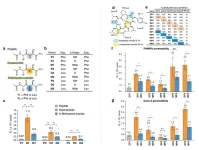(Press-News.org) Staphylococcus aureus. You may have had it in connection with a wound infection. In most cases, it will pass without treatment, while severe cases may require antibiotics, which kills the bacteria. This is the case for the majority of the population. In fact, many of us – though we feel perfectly fine – carry staphylococci in the nose, a good, moist environment in which the bacteria thrive.
However, more and more staphylococci are becoming resistant to antibiotics (also known as multi resistant staphylococcus aureus or MRSA), and these infections can be difficult to treat.
“Antibiotics resistance is an increasing problem, especially on a global scale. And when you have this relatively simple infection which suddenly cannot be treated with antibiotics, the situation can turn serious, sometimes life-threatening,” says Professor Niels Ødum from the LEO Foundation Skin Immunology Research Center at the University of Copenhagen.
Therefore, all over the world, a lot of resources are being invested in fighting antibiotics resistance in staphylococcus aureus infections, and a new study among skin lymphoma patients has produced positive results. A new substance called endolysins has proven capable of killing both resistant and non-resistant staphylococcus aureus – without the need for antibiotics. But we will get back to that.
The discovery is good news to patients with a weak immune system to whom a staphylococcus aureus infection can be serious and, at worst, fatal. But it also adds to the knowledge we have of other forms of treatment.
“To people who are severely ill with e.g. skin lymphoma, staphylococci can be a huge, sometimes insoluble problem, as many are infected with a type of staphylococcus aureus that is resistant to antibiotics,” says Niels Ødum and adds:
“That is why we are careful not to give antibiotics to everyone, because we do not want to have to deal with more resistant bacteria. Therefore, it is important that we find new ways of treating - and not the least to prevent - these infections.”
New substance may be the answer
In some patients, a staphylococcus aureus will cause the cancer to worsen. And even though antibiotics appear to work in some cases, it is not without its problems.
“We can tell that giving high doses of antibiotics to patients with serious infections causes their health, skin and cancer symptoms to improve. But once we stop giving them antibiotics, the symptoms and staphylococci quickly return. Patients experience many adverse effects, and some risk getting resistant bacteria,” says Niels Ødum.
Therefore, treating staphylococcus aureus can be tricky. At worst, cancer patients may die of an infection which doctors are unable to treat.
And this is where endolysins enter the scene, as this new substance may be part of the solution to antibiotics resistance like MRSA.
“This particular endolysin is a brand new, artificially produced enzyme that has been improved several times and designed as a new drug,” explains Postdoc Emil Pallesen, who is first author of the study. He adds:
“The great thing about this enzyme is that it has been designed to penetrate the wall of staphylococcus aureus. This enables it to target and kill the harmful staphylococcus and leave harmless skin bacteria unharmed.”
And that is what made the researchers decide to test the new substance; they expected it to be able to kill both resistant and non-resistant staphylococcus bacteria.
“We have been testing the substance on skin samples from patients, and it does appear to kill staphylococcus aureus from patients. Endolysins do not care whether the bacterium is resistant to antibiotics or not, because it does not work in the same way as antibiotics,” says Niels Ødum and adds:
“The really good news is that our lab tests have showed that endolysins do not just eradicate staphylococcus aureus; they also inhibit their ability to promote cancer growth.”
The study, "Endolysin inhibits skin colonization by patient-derived Staphylococcus aureus and malignant T cell activation in cutaneous T cell lymphoma", is published in the Journal of Investigative Dermatology.
END
Resistant bacteria are a global problem. Now researchers may have found the solution
2023-03-17
ELSE PRESS RELEASES FROM THIS DATE:
An elegant new orchid hiding in plain sight
2023-03-17
It is extremely rare for a new plant species to be discovered in Japan, a nation where flora has been extensively studied and documented. Nevertheless, Professor SUETSUGU Kenji and his associates recently uncovered a stunning new species of orchid whose rosy pink petals bear a striking resemblance to glasswork (Fig. 1). Since it was initially spotted near Hachijo Island in Tokyo Prefecture, the new species has been given the name Spiranthes hachijoensis. Interestingly, it can be found in familiar environments such as lawns and parks, and even in private gardens and on balconies. This research suggests ...
Investigating the effects on amide-to-ester substitutions on membrane permeability of cyclic peptides
2023-03-17
Cyclic peptides often exhibit low membrane permeability which can be significantly improved via amide-to-ester substitutions—as demonstrated by researchers from Tokyo Institute of Technology (Tokyo Tech). The utilization of substitutions shown in this study can be used to develop cyclic peptides with high membrane permeability and oral bioavailability for clinical and therapeutic applications.
Interest in cyclic peptides, a class of organic molecules, has reached a new high recently. Their ability as inhibitors has made them ...
EHRA 2023: The hottest science in heart rhythm disorders
2023-03-17
Date: 17 March 2023
16 to 18 April in Barcelona, Spain and online
Discover what’s new and on the horizon in the prevention and treatment of heart rhythm disorders at EHRA 2023, a scientific congress of the European Society of Cardiology (ESC).
The annual congress of the European Heart Rhythm Association (EHRA), a branch of the ESC, will be held 16 to 18 April at the Fira Gran Via, Hall 8, in Barcelona, Spain and online. Explore the scientific programme.
Novel research ...
Study shines new light on ancient microbial dark matter
2023-03-17
Bacteria are literally everywhere – in oceans, in soils, in extreme environments like hot springs, and even alongside and inside other organisms including humans. They’re nearly invisible, yet they play a big role in almost every facet of life on Earth.
Despite their abundance, surprisingly little is known about many microorganisms that have existed for billions of years.
This includes an entire lineage of nano-sized bacteria dubbed Omnitrophota. These bacteria, first discovered based on short fragments of DNA just 25 years ago, are common in many environments around the world but have been poorly understood. Until now.
An international ...
An age-old battle: Scientists uncover what makes malaria such a wily foe
2023-03-17
Plasmodium falciparum, the parasite that causes the deadliest form of malaria in humans, is a master evader, and has dodged all attempts at an effective and durable vaccine. Now, using a sophisticated method that characterizes how antibodies respond to all of the parasite’s roughly 5,400 proteins, researchers at Chan Zuckerberg Biohub–San Francisco (CZ Biohub SF) and UC San Francisco (UCSF) have created the first high-resolution map of the human immune response to P. falciparum, offering insight into what makes this parasite such a persistent pathogen.
In a study published in eLife ...
Study reveals your loveable pet dog or cat could lead to restless nights
2023-03-17
A new study published in the CABI journal Human-Animal Interactions reveals that your lovable pet dog or cat may lead to you having more restless nights than those graced with long periods of peaceful sleep.
The research, led by Dr Lauren Wisnieski of Lincoln Memorial University, USA, focussed specifically on pet ownership in the USA and drew upon data from the National Health and Nutrition Examination Survey (NHANES) conducted in 2005-2006.
Dr Wisnieski, Assistant Professor of Public Health and Research and Affiliation, found that ...
AADOCR announces IADR/AADOCR Journal of Dental Research “Cover of the Year, 2022”
2023-03-17
Alexandria, VA, USA – The American Association for Dental, Oral and Craniofacial Research (AADOCR) has announced the IADR/AADOCR Journal of Dental Research (JDR) Cover of the Year, 2022 for the paper, “MUC1 and Polarity Markers INADL and SCRIB Identify Salivary Ductal Cells.” The winners were recognized during the Opening Ceremonies of the 52nd Annual Meeting of the AADOCR, held in conjunction with the 47th Annual Meeting of the Canadian Association for Dental Research (CADR), that took place on March 15, 2023.
In this study, authors D. Wu, P.J. Chapela, C.M.L. Barrows, D.A. Harrington, D.D. Carson, R.L. Witt, N.G. Mohyuddin, S. Pradhan-Bhatt, and ...
Astha Singhal, Cameron Randall and Tamanna Tiwari, named first recipients of the AADOCR Delta Dental Institute Oral Health Equity Research Award
2023-03-17
Alexandria, VA – The American Association for Dental, Oral, and Craniofacial Research has named Astha Singhal, Boston University, MA, and the team of Cameron Randall, University of Washington, Seattle, and Tamanna Tiwari, University of Colorado, Aurora the inaugural recipients of the AADOCR Delta Dental Institute Oral Health Equity Research Award.
Established for this year with generous support from the Delta Dental Institute, the Oral Health Equity Research Award supports two research awards of $25,000 each in the areas of 1) advancing recommendations for greater oral health equity in populations that lack access to dental ...
THE LANCET PUBLIC HEALTH: Elite football players are more likely to develop dementia, suggests Swedish study
2023-03-17
Peer-reviewed / Observational study / People
New study including 6,007 male football (soccer) players who played in the Swedish top division between 1924 to 2019 suggests they were 1.5 times more likely to develop neurodegenerative disease compared to population controls.
Elite football players had increased risk of developing Alzheimer’s disease and other dementias, but their risk was not increased for motor neuron disease (including ALS), and their risk of Parkinson’s disease was lower compared to controls.
Unlike outfield ...
An extra X chromosome-linked gene may explain decreased viral infection severity in females
2023-03-17
It has long been known that viral infections can be more severe in males than females, but the question as to why has remained a mystery – until possibly now. The key may lie in an epigenetic regulator that boosts the activity of specialized anti-viral immune cells known as natural killer (NK) cells.
In a study published March 16 in the peer-reviewed journal Nature Immunology, a collaborative team of UCLA researchers have found that female mouse and human NK cells have an extra copy of an X chromosome-linked gene called UTX. UTX acts as an epigenetic regulator to boost NK cell ...


